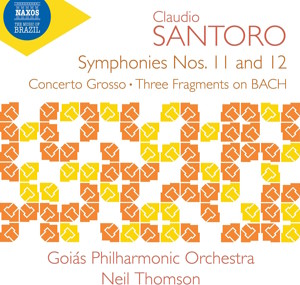
Claudio Santoro (1919-1989)
Concerto Grosso (1980)
Symphony No. 11 (1984)
Três fragmentos sobre BACH (1985)
Symphony No. 12 (1987, rev. 1988/1989)
Goiás Philharmonic Orchestra/Neil Thomson
rec. 2019/22, Centro Cultural Oscar Niemeyer & Teatro Escola Basileu França, Goiâna, Brazil
NAXOS 8.574406 [69]
Claudio Santoro spent almost ten years in Germany as professor at the Heidelberg-Mannheim Staatliche Hochschule für Musik. He returned to Brazil in 1978 and was endowed with a number of cultural tasks, which nevertheless allowed him to compose. Compose he did, and his last decade proved remarkably prolific. The four works here come from that period, and show him venturing into new musical territories he encountered in Germany. The somewhat nationalistic stylistic leanings in many earlier works are no longer the norm. Moreover, the Concerto Grosso for string quartet and string orchestra is all but a far cry from the Neo-classical piece the title might imply. The overall structure of the work is still fairly straightforward. Even so, the writing relies on clusters and aleatory elements, although they do not exclude more traditional ones. The global impression the music makes is one of terseness and stringency, quite often reminiscent of, say, Bartók or Honegger, to mention but two who readily come to mind.
The Symphony No. 11 is also remarkably compact. According to the words of Gustavo de Sá in his excellent notes, it is the densest and the most dramatic of the whole cycle. The first movement begins with a long, desolate oboe solo. It casts an ominous shadow over the introduction until other instruments join in, and the main part of the movement is duly launched. After some development, the discourse is briefly interrupted by a short violin solo reminiscent of the opening. The movement ends in the same desolate atmosphere. This is quickly dispelled by the short, nervous Scherzo. The third movement acts as a recapitulation of sorts; it pulls almost all preceding elements together until the music disappears.
Três fragmentos sobre BACH marked the 300th anniversary of Johann Sebastian Bach’s birth. The piece was written at the request of Gerald Kegelmann, a German colleague of Santoro from Mannheim, for a local youth orchestra. The work is also not what one might have expected. It goes without saying that most thematic material is derived from the ubiquitous BACH sign. Santoro handled his basic material with considerable imagination and invention but he did not change his outlook. The music is once again rather dissonant, stringent and tense, while still quite exacting, technically speaking.
In 1983, Santoro wrote pieces for the second Sul América Young Musicians competition. The result was a series of fifteen Sul América Fantasias for solo instruments; there is even one for voice. (Sul América does not refer to Southern America but to the insurance company that sponsored the competition.) Santoro also wrote an optional orchestral accompaniment to each fantasia, probably so that finalists or winners could perform them in that format. The fantasias were composed in March and April 1983. They are now available on Naxos 8.574407, forthcoming shortly.
But this is not the end of the story. Santoro completed the Fantasia Concertante which essentially brought together elements of the solo work, with orchestra, using transitional bars to allow the music to flow without break. The Fantasia Concertante was never preformed as such. It eventually became the basis for Santoro’s Symphony No. 12.
The Symphony is subtitled Sinfonia concertante for eight instruments and orchestra (the trombone was later added as a ninth instrument), and it is exactly what its subtitle implies. Solo episodes are woven into the orchestral fabric either to introduce sections or to act as a coda to others. The first movement opens with a solo for violin and cello, and concludes with a recapitulation of the first theme, now entrusted to the viola. The second movement is comparatively short, a sort of mini-concerto for trumpet and orchestra. The final movement once again brings a number of instrumental episodes, some in the form of short cadenzas. The trombone has now its sole appearance in the work. It develops the horn’s theme and leads the work to its vibrant, assertive close. In spite of its rather chequered genesis, the Symphony No. 12 is quite an impressive piece of music and, once more, stylistically close to Honegger, Bartók and even Frank Martin. (One may think here of Martin’s 1949 Concerto pour 7 instruments à vent, timbales, batterie et orchestre à cordes, and none the worse for it, I hasten to add.)
This fine release is the second volume in an ongoing cycle devoted to Santoro’s symphonic music. The excellent, committed performances are well recorded in fine sound. I do not know what forthcoming volumes will bring but, as far as I am concerned, I believe that this disc is the place to begin exploring Santoro’s output. The programme unquestionably reveals his real stature as a symphonist. I will also note that Gustavo de Sá’s notes are well informed indeed, and add considerably to the interest of this disc.
Hubert Culot
Help us financially by purchasing from





















